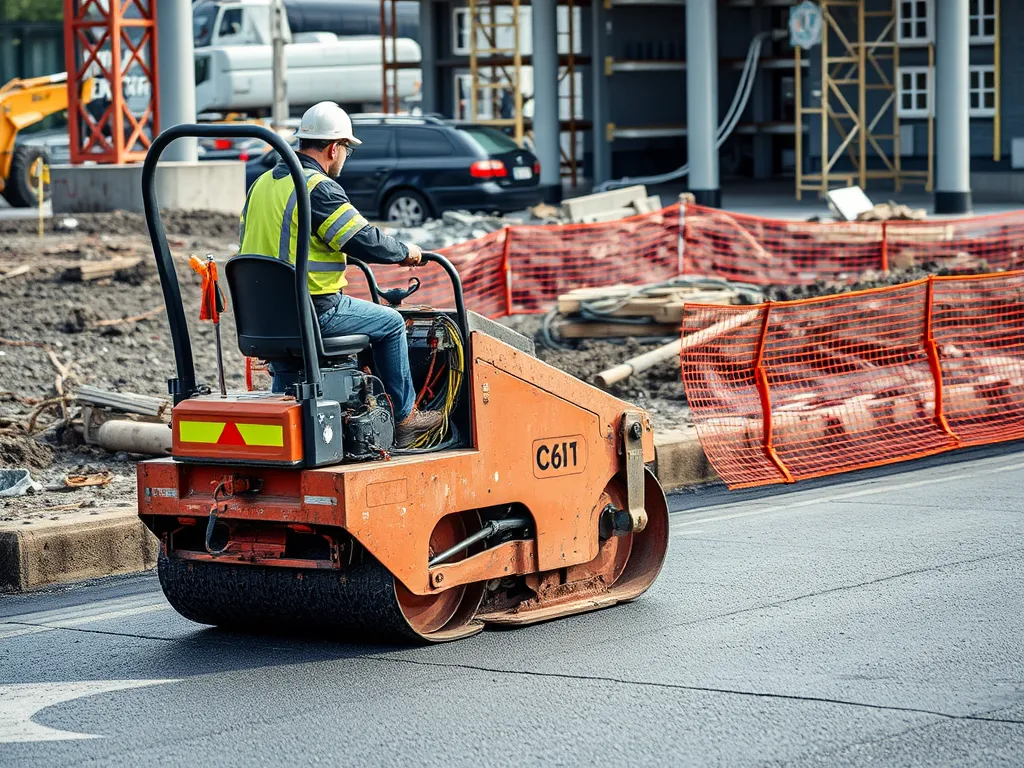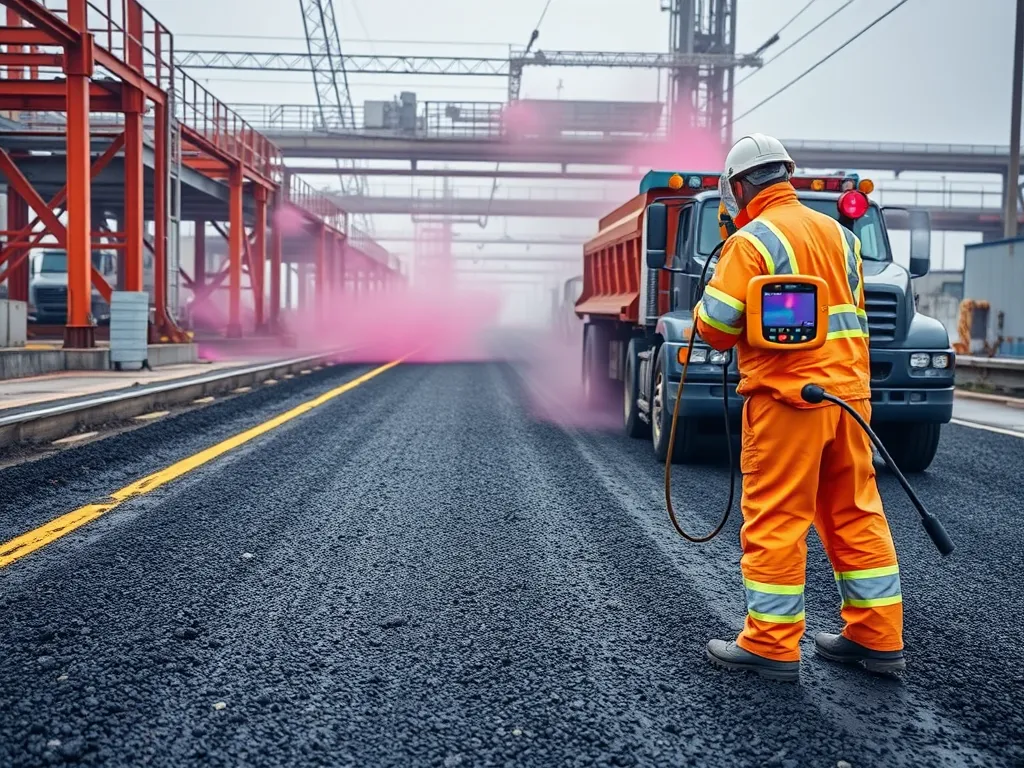Why Asphalt Safety Education Matters in Every Community
Published on: October 25, 2025 | Last Updated: April 14, 2025
Written By: George Voss
Community education on asphalt safety teaches residents and workers to handle asphalt materials safely during paving, repairs, or recycling. These programs focus on preventing injuries from hot mix (300°F) and fumes while promoting OSHA-compliant practices. They combine classroom lessons with hands-on drills to address real-world risks in road construction and driveway projects.
This article explains asphalt safety risks, from burns to equipment dangers. You’ll learn about required PPE like heat-resistant gloves, find free NAPA certification courses, and explore eco-friendly methods to reduce emissions. We break down safety checklists, training options, and answers to common questions about protecting your team and neighborhood.
Contents
- Introduction to Asphalt Safety Awareness
- The Necessity Of Asphalt Safety Training
- Core Asphalt Safety Precautions
- Asphalt Safety Training Programs
- Available Asphalt Training Resources
- Preventing Asphalt-related Risks
- Environmental Considerations in Asphalt Safety
- FAQ: Community Education on Asphalt Safety
- Closing Thoughts
- Useful References for You:
Introduction to Asphalt Safety Awareness
Asphalt shapes our roads, driveways, and play areas. Yet its risks stay hidden. Hot mix temps, toxic fumes, and slick surfaces harm workers and families. Teaching asphalt safety saves lives. It builds trust where we live, work, and play.
Why Community Education on Asphalt Matters
Each year, 4,500 U.S. workers face asphalt burns or lung harm (OSHA). Kids near paving sites risk skin burns from fresh blacktop. Drivers hit loose gravel in repair zones. Training cuts these dangers. It turns neighbors into first-line defenders.
- Workers learn to dodge 300°F mix burns
- Parents spot unsafe play zones near paving jobs
- Drivers slow down near orange cones and flaggers
Defining Key Asphalt Safety Terms
Know these terms to grasp asphalt risks:
- Asphalt fumes: Smoke from hot mix. Contains benzene, a cancer risk.
- Thermal burns: Skin harm from 250-350°F asphalt.
- PPE: Gear like gloves, masks, boots.
- Mix temps: Heat levels for paving (275-325°F).
- Compaction zones: Areas where rollers press hot asphalt.
With these terms clear, let’s move to the core safety steps needed for safe asphalt work.
The Necessity Of Asphalt Safety Training
Proper instruction builds the foundation for reducing injuries linked to paving projects. Workers without certified instruction face higher risks during mixing, laying, or repair tasks. Training equips crews with skills to identify dangers before they escalate.
Health Risks From Asphalt Exposure
Hot mix emits fumes containing volatile compounds like polycyclic aromatic hydrocarbons (PAHs). Direct contact with heated materials exceeding 300°F triggers burns. Without safeguards, repeated exposure harms respiratory systems over time.
Short-Term and Long-Term Effects
Immediate symptoms include eye irritation, dizziness, or skin inflammation. Prolonged contact correlates with chronic lung issues or skin disorders. Studies show workers exposed 10+ years exhibit higher rates of respiratory complications.
Common Asphalt Workplace Hazards
Over 35% of paving injuries stem from equipment misuse or insufficient ventilation. New crew members face elevated risks without mentoring on site-specific protocols.
Burns, Fumes, and Equipment Risks
Thermal burns occur when handling mix above 275°F or faulty machinery. Inhalation risks spike in confined spaces lacking exhaust systems. Rotating drum mixers, rollers, or compactors require strict lockout-tagout procedures to prevent crushing incidents.
Building robust community asphalt safety programs bridges knowledge gaps between crews, residents, and project planners. Next, let’s explore core protocols that keep worksites compliant.

Core Asphalt Safety Precautions
Following asphalt safety protocols shields workers and community members from harm. Proper planning, action, and follow-through form a three-part shield against common risks.
Pre-work Safety Checks
Start with a full scan of tools, machinery, and work zones. Confirm all parts function as built to avoid malfunctions during paving.
Inspecting Equipment and Materials
Check pavers, compactors, and temperature gauging tools daily. Hot mix asphalt (HMA) arrives at 300°F–350°F—confirm thermal controls work to stop burns. Look for cracks in compaction tools or worn paver augers. A single faulty part can halt operations or spark hazards.
Protective Measures During Asphalt Work
Active guarding against physical and chemical risks is vital. Prioritize both physical barriers and air quality controls.
PPE and Ventilation Best Practices
Outfit crews with NIOSH-approved respirators (P100 filters), heat-resistant gloves, and ASTM F2413-11 boots. Install local exhaust systems within 15 ft of HMA laydown areas to cut fumes. OSHA caps particulate contact at 5 mg/m³ over 8 hours—monitor air quality with real-time sensors.
Post-work Safety Protocols
Post-job routines stop lingering threats. Cool-down, clean-up, and containment form a triad of post-paving safety.
Cleanup and Debris Management
Let machinery cool below 125°F prior to washing. Vacuum loose aggregate to stop slips; bag HMA scraps in sealable containers. Store unused asphalt in insulated trucks at 250°F for up to 72 hours. Recycling plants accept old material—divert 95% of waste from landfills via asphalt reclaiming.
Grasping basic safety protocols forms a foundation for diving into formal asphalt safety training programs. Up next: how structured courses turn theory into action.
Also See: Analyzing the Cost-effectiveness Of Asphalt Mixes by Climate
Asphalt Safety Training Programs
Structured training programs form a vital part of community asphalt safety. Such initiatives build skills to cut risks during paving tasks. Both novices and pros gain from standard protocols that focus on hazard control.
Asphalt 101: Foundational Safety Skills
Foundational training gives workers critical skills for daily tasks. Programs focus on spotting dangers, using tools right, and applying first aid. Topics span from mix handling to avoiding burns from hot asphalt (typically 300°F+).
Key Topics Covered in Basic Training
| Topic | Details |
|---|---|
| PPE Usage | Hard hats, gloves, heat-resistant boots |
| Fume Control | Limiting contact with vapors via airflow tactics |
| Burn First Aid | Immediate cooling, avoiding ointments on asphalt burns |
| Mix Transport | Safe hauling of hot asphalt to avoid spills |
Advanced Asphalt Paving Training
Advanced paving training dives into complex tasks. Participants study mix layering, joint construction, and compaction. Such training boosts skills for jobs requiring accuracy, such as highway projects or parking lot paving.
Gear Operation and Maintenance
Handling paving machinery demands skill and caution. Training includes daily checks on oil levels, hydraulic systems, and paver parts. Workers practice starting and stopping machinery smoothly to avoid spills or injuries.
Free Online Asphalt Certification Opportunities
Digital platforms now offer no-cost paths to asphalt qualifications. NAPA’s training portal hosts 10+ courses on safety, mix design, and paving standards. OSHA also provides tools for hazard communication and OSHA 10-hour construction training.
Looking for hands-on instruction? Local paving schools and NAPA guides provide practical training options tailored to community needs.

Available Asphalt Training Resources
Communities aiming to boost asphalt safety skills training can tap into a mix of local and national programs. From hands-on paving schools to industry-backed manuals, tools exist to fit varying skill levels and budgets.
Finding Local Asphalt Paving Schools
Many community colleges and trade schools offer asphalt paving training. Programs like ABC Paving School (California) or XYZ Technical Institute (Texas) teach hot mix asphalt handling, compaction methods, and paver operation. Courses typically run 8-12 weeks, costing $1,200-$2,500. Local road departments often partner with schools to fund community asphalt safety workshops.
National Asphalt Pavement Association (NAPA) Guides
NAPA provides 40+ free manuals for asphalt safety training program leaders. Their “Community Guide to Asphalt Safety” outlines steps to organize town hall sessions, worksite audits, and hazard reporting systems. Download materials at asphaltpavement.org under “Safety Resources.”
Safety Handbooks and Compliance Standards
NAPA’s “Asphalt Pavement Safety & Health Guidelines” details 23 OSHA compliance points, including fume limits (0.5 mg/m³ benzene) and burn treatment protocols. Handbooks come in Spanish, Vietnamese, and English. Print copies cost $75; digital versions are free for community asphalt safety groups.
With training resources in hand, communities can shift focus to daily practices that cut risks. Up next: tactics to stop common paving hazards before work starts.
Reducing risks tied to paving requires combining technical know-how with community-focused training. Proper methods curb common issues like segregation or extended drying periods, lowering injury rates.
Minimizing Asphalt Segregation
Segregation occurs when paving mix components separate, weakening pavement integrity. This creates uneven surfaces, tripping hazards, or premature cracks. Community asphalt safety training teaches crews to spot early signs like uneven texture or color shifts.
Causes and Prevention Strategies
Key causes include improper truck loading, excessive material handling, or temperature mismatches. Prevention focuses on:
| Cause | Solution |
|---|---|
| Poor mixing | Use continuous feed systems |
| Long haul distances | Maintain mix temps above 280°F |
| Rough handling | Limit shovel work; avoid drop heights over 6 ft |
Educational programs stress regular mix testing during pours. Crews trained in PG binder specs reduce segregation by 40%.
Improving Asphalt Drying Times for Safety
Slow-drying pavement elevates burn risks or vehicle skidding. Drying speed hinges on mix design, weather, and compaction methods. Community education asphalt safety initiatives promote using warm-mix technologies, cutting curing periods by 30% versus traditional hot mixes.
Training covers infrared thermometers to track surface temps below 140°F before reopening roads. Local crews learn to adjust paving schedules based on humidity levels below 70% or temperatures exceeding 50°F.
Next, we’ll explore how sustainable methods further boost safety while protecting ecosystems.

Environmental Considerations in Asphalt Safety
Safe asphalt use goes beyond gear and rules. It ties to how we care for land, air, and water. Teaching crews and towns about green steps builds safer sites and cleaner neighborhoods.
Sustainable Asphalt Practices
New methods cut harm while keeping roads strong. Warm-mix asphalt needs less heat, slashing fuel use by 35%. Porous asphalt lets rain soak into soil, not flood streets. These steps lower risks for workers and locals.
Recycling and Emission Reduction
Old roads get new life through RAP (Recycled Asphalt Pavement). A 50% RAP mix trims CO2 by 20% and saves $15 per ton. Plants now trap fumes with baghouse filters, cutting lung irritants by 90%.
| Practice | Impact | Community Benefit |
|---|---|---|
| RAP use | 30% less waste | Cleaner job sites |
| Low-VOC binders | 50% fewer fumes | Safer air near plants |
| Night paving | Less traffic heat | Lower ozone levels |
Local asphalt safety training now shows crews how to sort scrap, run clean gear, and report spills fast. Town halls share air test data so schools and parks stay clear of plant emissions.
Want to know how these green steps link to daily work risks? Let’s break down key health safeguards every team needs.
FAQ: Community Education on Asphalt Safety
What PPE is Required for Asphalt Work?
Personal Protective Equipment (PPE) essential for asphalt work includes hard hats, heat-resistant gloves, safety goggles, respirators (NIOSH-approved with P100 filters), and durable work boots that meet ASTM F2413-11 standards. These items help protect workers from burns, exposure to harmful fumes, and potential injuries from equipment.
How to Access Free Online Asphalt Courses?
You can access free online asphalt courses through resources like the National Asphalt Pavement Association (NAPA) training portal, which offers various courses that cover safety protocols, mix design, and best practices in asphalt paving. Simply visit their website for registration and course options.
What Are the Risks Of Asphalt Fumes?
Asphalt fumes contain volatile organic compounds, which can cause short-term health issues like eye irritation and dizziness, as well as long-term respiratory problems when exposed consistently over time. It is important to minimize exposure through proper ventilation and the use of PPE like respirators.
Where to Find Asphalt Training Near Me?
To find asphalt training programs near you, check local community colleges, vocational schools, or trade organizations that specialize in asphalt paving. Many of these institutions offer hands-on courses and workshops aimed at enhancing safety practices and skills within your community.
Closing Thoughts
Community education on asphalt safety is vital for creating a safe environment for workers and the public. By imparting knowledge about health risks, protective measures, and available training programs, we can minimize accidents and health hazards. Emphasizing a culture of safety within asphalt operations leads to better practices and improved overall community well-being.
Stay informed and proactive. Explore resources like local asphalt training programs and certification opportunities to further enhance safety standards in your area. Continuous education is the key to reducing risks associated with asphalt work.
For comprehensive information on asphalt safety and community education, check out Asphalt Calculator USA. Equip yourself with the necessary tools to foster a safer asphalt environment.
Useful References for You:
- American Association of State Highway and Transportation Officials (AASHTO). (2008). Mechanistic-Empirical Pavement Design Guide (MEPDG). Washington, DC: AASHTO.
- How Does Asphalt Repair Contribute To Overall Community Safety?
- National Asphalt Pavement Association (NAPA) – National Asphalt Pavement Association
- New Study Highlights How the Arts Make Streets Safer | Americans for the Arts
- Safety


